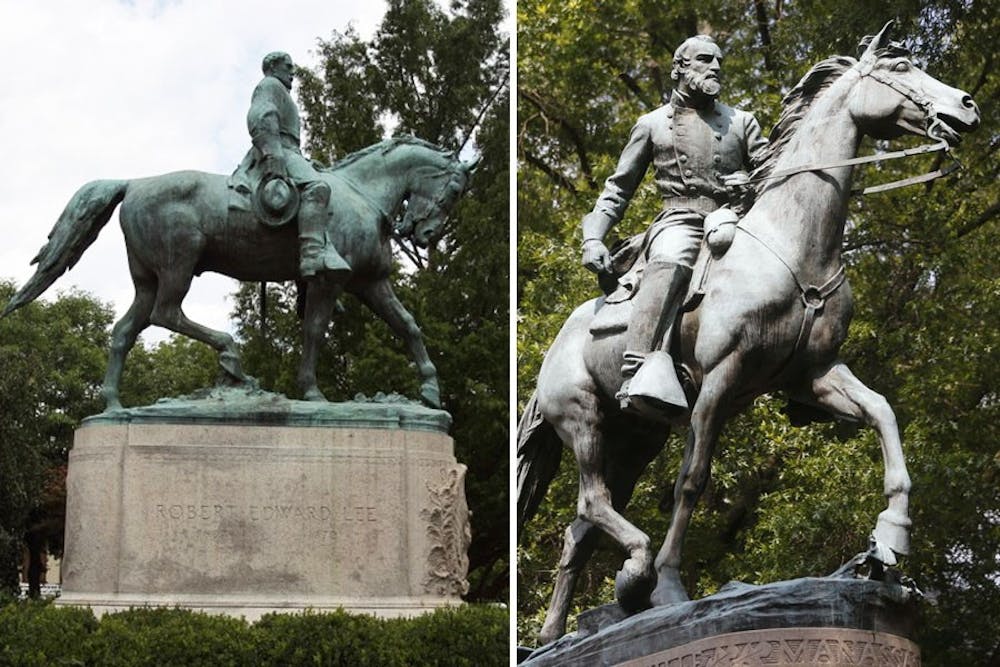Lea en español
The Charlottesville City Council voted unanimously to remove the Robert E. Lee and Stonewall Jackson statues during a public hearing Monday night, taking action that has been four years in the making. The earliest that the statues can be removed is 30 days from Monday on July 8.
The City first voted to remove the statue of Robert E. Lee in February 2017, but the removal attempt was challenged by the Monument Fund, the Virginia Division of Sons of Confederate Veterans and numerous individual plaintiffs who filed complaints, citing state code §15.2-1812 — a code passed by the General Assembly in 1997 that bans localities from removing, interfering with and contextualizing or covering monuments without following appropriate guidelines
The Lee and Jackson statues served as rallying points during the Unite the Right rally in August 2017, when alt-right groups and white supremacists marched down the Lawn with torches and held a violent rally in downtown Charlottesville, resulting in three deaths and 19 injuries. Jason Kessler, a white nationalist organizer of the rally, said the rally was intended to criticize the City Council’s vote in favor of removing the Lee statue.
Following the rally, the City placed black tarps over both statues to mourn the lives lost, and in September 2017, City Council passed another resolution to remove both statues. In October 2017, however, the circuit court ruled that state code §15.2-1812 could be applied retroactively to statues built in the 1920s, and thus the City did not have the authority to remove them.
In April 2020, Governor Ralph Northam effectively overturned the previous prohibition on removal after signing a bill authorizing individual localities to remove, relocate or contextualize Confederate statues and monuments within their communities. A year later, the Supreme Court of Virginia ruled that the Lee and Jackson statues were never subject to state code §15.2-1812 because, reading with a “plain language analysis,” the code only applied to statues erected after 1997. The Lee statue was erected in 1924 while the Jackson statue was erected in 1921 — over half a century before the code was passed.
Fifty-five community members spoke at Monday’s public hearing, with all but six urging the city to remove the statues. Several speakers requested that the statues be removed before the four-year anniversary of the Aug. 11-12 Unite the Right rally.
“The [Lee] statue attracts violent, radical extremists from all over the state and all over the county,” resident Kat Maybury said.
Many others discussed what to do with the statues after their removal. Rather than simply relocating the statues, they wanted a definitive end to the statues so that they can instead be utilized to promote healing. Artist Ramona Martinez suggested that they be melted and transformed into symbols of justice. At a previous Council meeting last month, residents had also suggested melting the bronze to create works of racial healing and justice.
Rising third-year College student Zyahna Bryant, who wrote a petition in 2016 advocating for the removal and renaming of the Lee statue, also spoke at the public hearing. Bryant’s original petition, written when she was in her freshman year of high school, sparked the conversation around removing Confederate monuments in Charlottesville and laid the groundwork for the recent decision. In response, City Council established the Blue Ribbon Commission on Race, Memorials and Public Spaces, which was tasked with drafting reports to address the monument controversy.
“What needs to happen is clear, and it’s up to you to make the right decision,” Bryant said. “There’s no opportunity left to straddle the fence. Which side of history do you want to be on? Which kind of ancestor do you all wish to be?”
The decision comes alongside a series of recent resolutions concerning the presence of Confederate monuments in the community. The Building and Grounds Committee of the Board of Visitors approved the rededication of the Frank Hume Memorial — a wall honoring Frank Hume, a Confederate soldier who served in the Virginia House of Delegates — during its meeting Friday. After voting to remove the George Rogers Clark statue last fall, the Board announced during the same meeting that the statue will be removed by the end of the summer.
The Robert E. Lee Memorial in Richmond also faces a hearing in front of the Supreme Court of Virginia Tuesday regarding whether the state can proceed with its removal.
For the 30-day period from June 7 through July 8, the City of Charlottesville is offering to transfer ownership of one or both of the statues to any museum, historical society, government or military battlefield interested in obtaining the statues for relocation. If either of the statues has not been transferred by July 8, the City may take additional action to have them covered, removed or placed in storage.







